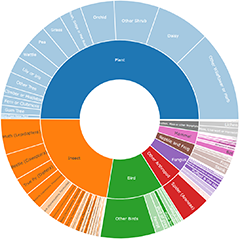Jelly-like; smooth, featureless surface
This sub-group holds those gelatinous fungi, amongst the group commonly referred to as jelly fungi, that don’t fit into any of the previous categories. Those other jelly fungi may be:
Shelf-like
Stalk-like
Convoluted to brain-like
The fungi in this sub-group have smooth & featureless fruitbodies. If you have found a spotted and somewhat gelatinous fruitbody you probably have one of the soft-fruitbody species of Hypocrea, included in the next sub-group.
Announcements
There are currently no announcements.
Discussion
Teresa
wrote:
15 Apr 2025
Looks a little like a dehydrated Tremella sp.
Unverified Jelly-like; smooth, featureless surface
Heino1
wrote:
6 Dec 2024
Fresh Heterotextus fruitbodies are pendulous with a narrow attachment point and then broadening downward. From a short distance away one of these resembles a broad, upside-down cone. The lower surface may be more or less flattish or curved a little upward (then resulting in a fruitbody that has a slight resemblance to an upside-down cup. As the fruitbodies dry they may become more cup-like or somewhat irregular in form. If a fungus on wood is yellow to orange and looks like an upside down cup it’s probably a Heterotextus. Though it can be harder to tell when fruitbodies are immature or greatly dried.
There certainly are yellow to orange, wood-inhabiting ascomycetes, which may angle their cup-like surfaces in various directions, though mostly the cups face upward. Some of the orange species of Orbilia might be confused with Heterotextus. However, Orbilia frutibodies are typically gregarious, closely packed and they don’t expand to resemble a broad cone.
There certainly are yellow to orange, wood-inhabiting ascomycetes, which may angle their cup-like surfaces in various directions, though mostly the cups face upward. Some of the orange species of Orbilia might be confused with Heterotextus. However, Orbilia frutibodies are typically gregarious, closely packed and they don’t expand to resemble a broad cone.
Heterotextus sp.
Top contributors
- trevorpreston 18
- Hejor1 8
- TimL 8
- JackyF 7
- KenT 5
- mahargiani 4
- Bushrevival 3
- Aussiegall 3
- RobG1 3
- Tapirlord 3
Top moderators
- Heino1 58
- Heinol 23
- Teresa 13
- Pam 7
- Heino 5
- MichaelMulvaney 5
- KenT 3
- Csteele4 3
- waltraud 1
- CanberraFungiGroup 1




